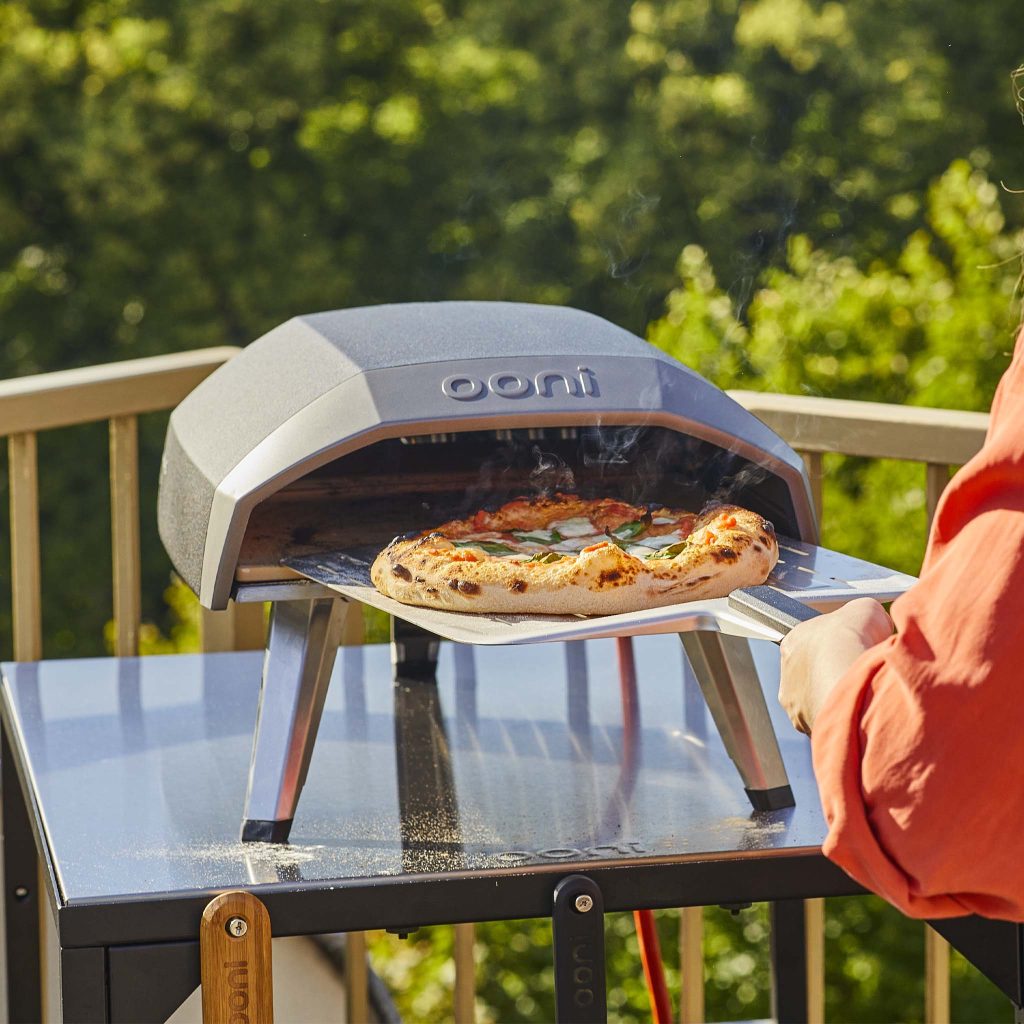As Vanlifers and hybrid campsite weekend warriors we are passionate about outdoor cooking and the amazing experiences it brings to the whole family as well as friends.
We have been meaning to write an article about outdoor cooking methods for a while where we can delve into various outdoor cooking methods, explore the unique benefits, techniques, and delicious recipes.
From BBQ to smoking, we’ll equip you with the knowledge you need to elevate your culinary skills and create memorable meals. Get ready to embark on a Vanlife Eats culinary adventure in the great outdoors!
BBQ Grilling
Outdoor BBQ cooking is a cherished tradition, bringing friends and family together to enjoy delicious grilled meals and the joy of cooking in the open air. With a wide range of BBQ cooking methods, you can create succulent meats, flavourful vegetables, and even grilled desserts. Let’s explore some popular outdoor BBQ cooking techniques that will help you master the art of grilling.
Direct Grilling
Direct grilling is a straightforward and widely used BBQ cooking method. It involves placing the food directly over the heat source, typically hot charcoal or gas burners. This technique is ideal for smaller, thinner cuts of meat, such as steaks, burgers, sausages, and skewered kebabs. The direct heat sears the exterior, creating those coveted grill marks and sealing in the juices for mouthwatering results.
Indirect Grilling
Indirect grilling is a technique that involves cooking food away from the direct heat source. In this method, you place the food on the grill grates next to, rather than directly over, the heat. This creates a gentler cooking environment, allowing for slower, more even cooking. Indirect grilling is perfect for larger cuts of meat, such as whole chickens, roasts, or ribs. It provides the opportunity to infuse smoky flavours and achieve tender, juicy results.
Smoking
Smoking is a BBQ cooking method that adds a distinct and irresistible smoky flavour to your food. It involves slow-cooking over low, indirect heat using wood chips or chunks, which release aromatic smoke. This method is commonly used for foods like ribs, briskets, or whole fish. The extended cooking time allows the smoke to penetrate the food, infusing it with a rich and smoky taste.
Rotisserie Cooking
Rotisserie cooking involves skewering the food on a rotating spit, which is then placed over the heat source. The constant rotation ensures even cooking and basting as the natural juices continuously coat the meat. Rotisserie cooking is excellent for larger cuts of meat, such as whole chickens, turkeys, or roasts. It delivers succulent, tender results with a crispy and flavourful exterior.
Grilling with Planks
Grilling with planks is a unique BBQ cooking method that imparts a delightful smoky and woody flavour to fish, meats, and vegetables. Soak wooden planks, such as cedar or maple, in water, and place them directly on the grill grates. Then, arrange the food on top of the planks and cook with the grill lid closed. This method is particularly popular for grilling salmon and other seafood, creating a moist and flavourful result.
Searing
Searing is a technique used to achieve a caramelised crust and locking in the juices of your food. It involves cooking food over high heat for a short period, usually at the beginning or end of the grilling process. Searing is commonly used for steaks, chops, or burgers, creating a delectable outer crust while maintaining a tender and juicy interior.
Gas Burners
A portable gas stove is a convenient and versatile option for outdoor cooking. Whether you’re camping, hiking, or enjoying a picnic, a portable gas stove allows you to prepare hot meals wherever you go. Here’s a guide on using a portable gas stove effectively for your outdoor culinary adventures.
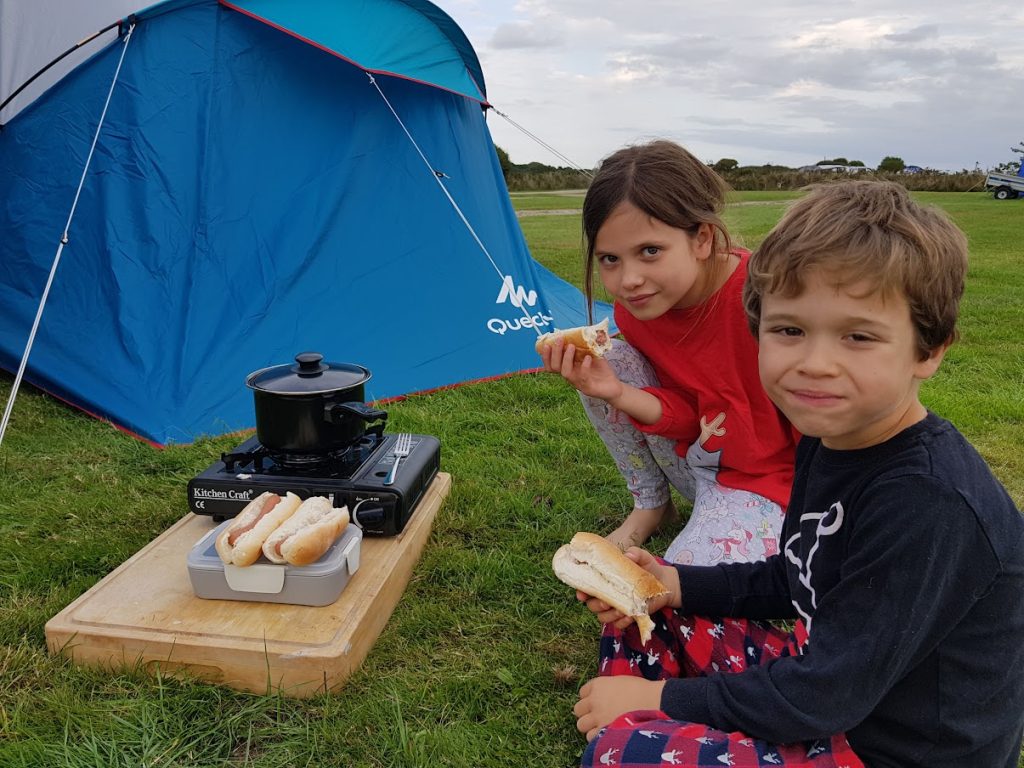
Choosing a Portable Gas Stove
When selecting a portable gas stove, consider factors such as size, weight, and fuel type. Opt for a compact and lightweight stove that is easy to carry and transport. Gas stoves usually run on butane or propane, so choose a stove compatible with the fuel canisters available in your area.
Setting Up the Stove
Start by finding a stable and level surface to place your portable gas stove. Ensure the area is well-ventilated and away from flammable materials. Follow the manufacturer’s instructions for assembling the stove, attaching the gas canister securely, and connecting the fuel line. Check for any gas leaks by applying a soapy water solution to the connections and looking for bubbles.
Igniting the Stove
Most portable gas stoves have a built-in ignition system, making it easy to start the flame. Turn the gas control knob to the “ignite” or “start” position and press the ignition button. If your stove doesn’t have an ignition system, use a long-reach lighter or match to light the burner. Keep your face and hands clear of the stove while igniting it.
Regulating the Flame
Once the stove is ignited, adjust the flame to the desired heat level. Gas stoves usually have a control knob that allows you to increase or decrease the flame intensity. For simmering or gentle heat, turn the knob to the lowest setting. For higher heat, turn it up gradually until you reach the desired temperature. Remember to monitor the flame and make adjustments as needed throughout the cooking process.
Cooking on the Stove
Portable gas stoves offer a range of cooking options. You can use a variety of cookware, including pots, pans, and griddles. Ensure that the cookware is compatible with the stove and fits securely on the burner. Cook your meals as you would on a regular stove, whether it’s boiling water, frying, sautéing, or simmering. Follow your recipes and adjust cooking times and temperatures accordingly.
Safety Precautions
When using a portable gas stove, always prioritise safety. Never leave the stove unattended while it’s in use. Keep flammable materials away from the stove and ensure there is sufficient ventilation. If using the stove indoors, make sure the area is well-ventilated and follow any guidelines or restrictions regarding indoor cooking. After use, allow the stove to cool down completely before disassembling or storing it.
Wood Burner Cooking
Using a wood burner for outdoor cooking can elevate your culinary experience to new heights. Our favourite brand is Winnerwell, who offer a wood burner specifically designed for cooking purposes. With its tall chimney, this wood burner effectively directs smoke away from the cooking area, ensuring a clean and enjoyable environment. Let’s explore the unique features and benefits of this method and how to cook with a cast iron skillet pan on the base of the burner.
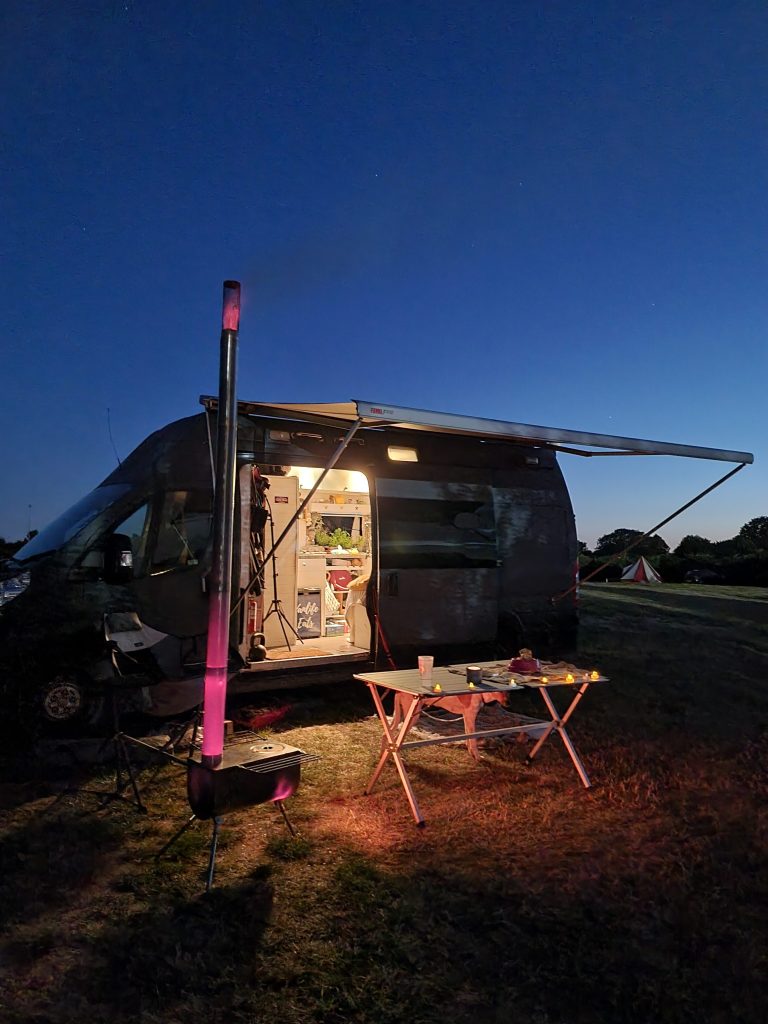
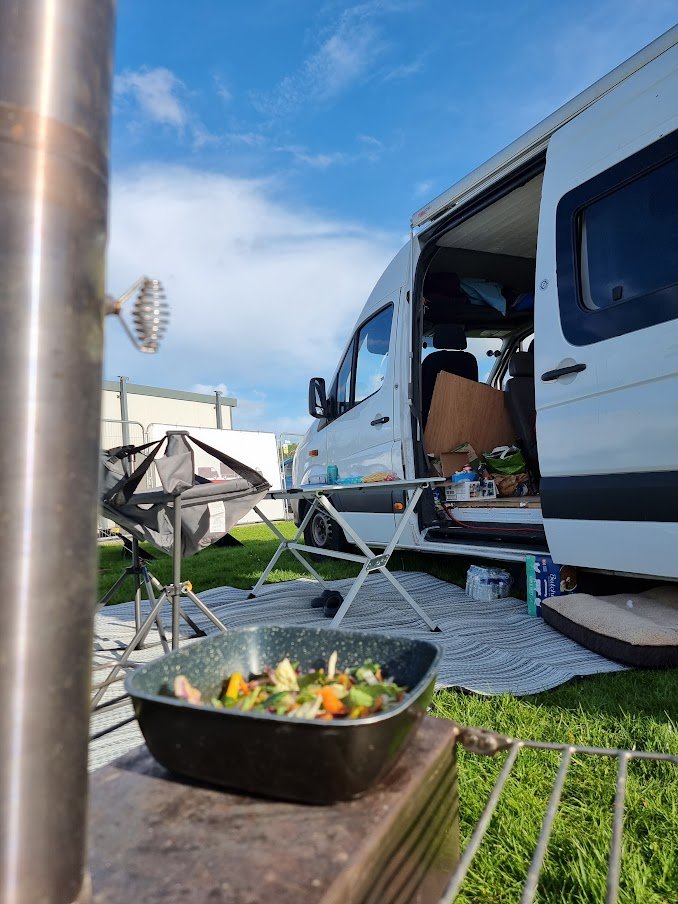
The Wood Burner
The wood burner is a reliable and efficient outdoor cooking appliance. Its durable construction and thoughtful design make it perfect for camping trips, backyard gatherings, or any outdoor adventure. The tall chimney provides excellent ventilation, reducing the amount of smoke that comes into contact with your food while maintaining a controlled fire.
Setting Up the Wood Burner
Begin by selecting a safe and stable location for your wood burner. Place it on a non-flammable surface, ensuring it is away from any objects that could catch fire. Assemble the wood burner according to the manufacturer’s instructions, making sure the chimney is securely attached. Once set up, gather dry, seasoned firewood to fuel your cooking fire.
Preparing the Cast Iron Skillet
A cast iron skillet is an ideal cooking tool for wood burner cooking due to its excellent heat retention and even distribution. Before using the skillet, make sure it is properly seasoned by applying a thin layer of oil and heating it on the wood burner until it smokes. This process creates a natural non-stick surface and enhances the skillet’s longevity.
Cooking on the Wood Burner
Once the wood burner is set up and the skillet is seasoned, you’re ready to start cooking. Begin by building a fire in the burner using small pieces of firewood or kindling. As the fire burns, adjust the airflow through the chimney to control the heat intensity. Place the cast iron skillet directly on the base of the burner, allowing it to heat gradually.
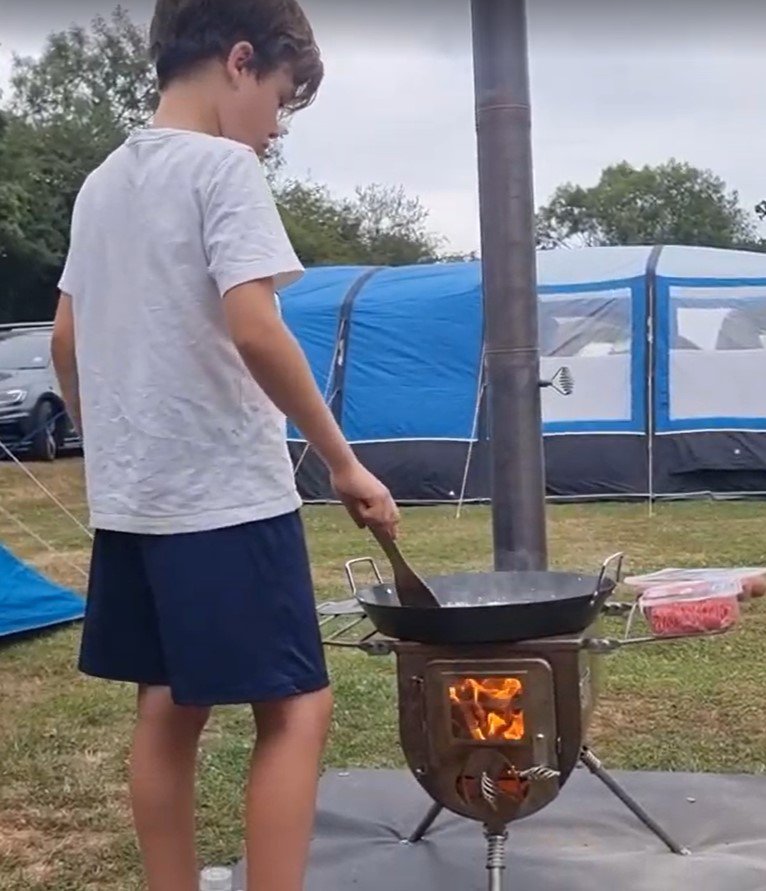
Mastering Wood Burner Recipes
With the wood burner and cast iron skillet ready, you can cook a wide range of dishes. Sear succulent steaks, grill vegetables, sauté stir-fries, or prepare flavourful stews. The versatility of the wood burner allows you to experiment with different cooking techniques and enjoy the unique smoky flavours that come from cooking over a wood fire.
Safety Considerations
While wood burner cooking offers a delightful experience, it’s important to prioritise safety. Ensure that the wood burner is placed on a stable surface, away from flammable materials and any potential fire hazards. Monitor the fire closely, and never leave it unattended. Once you have finished cooking, allow the wood burner to cool completely before disassembling or storing it.
Smoking
Smoking is an ancient outdoor cooking method that imparts rich, smoky flavors to a variety of ingredients. From meats to vegetables, this slow and low technique transforms ordinary ingredients into culinary masterpieces.
Types of Smokers
Explore different types of smokers, including:
- Offset Smokers: These traditional smokers feature a firebox attached to the cooking chamber, allowing for precise temperature control.
- Electric Smokers: Ideal for beginners, electric smokers offer convenience and simplicity, requiring minimal attention.
- Pellet Smokers: These innovative smokers utilise wood pellets to create a consistent smoke, infusing the food with robust flavours.
Fire Pit Cooking
Fire pit cooking adds a touch of rustic charm to outdoor dining, allowing you to enjoy the warmth and ambiance of a crackling fire while preparing delicious meals. Whether you’re camping, hosting a backyard gathering, or simply enjoying a cosy evening, fire pit cooking offers a unique culinary experience. Let’s delve into the world of fire pit cooking and explore how to make the most of this versatile method.
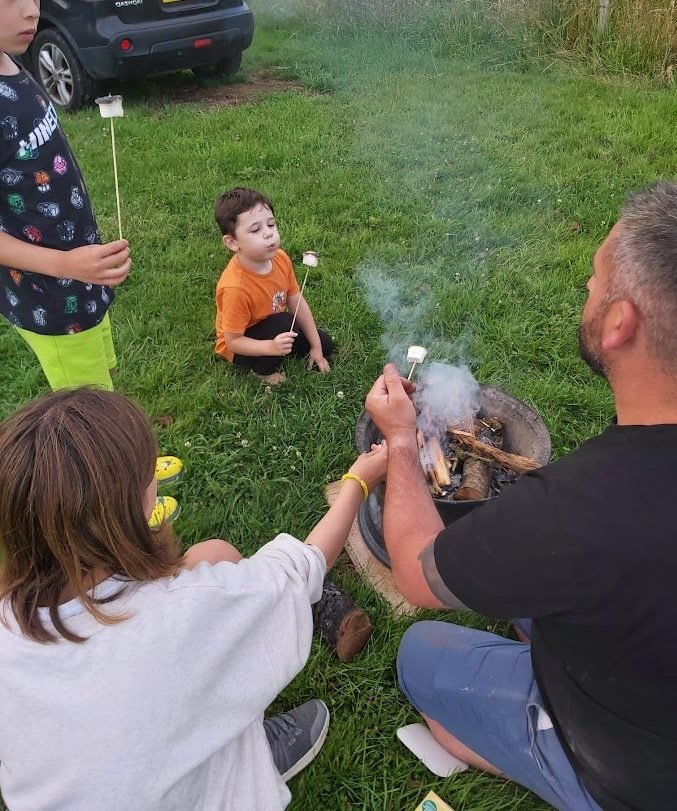
Choosing a Fire Pit
Selecting the right fire pit is essential for successful fire pit cooking. Consider the size, material, and design that best suits your needs. Opt for a fire pit that is sturdy, heat-resistant, and has a removable grill grate or cooking surface. This will enable you to cook directly over the fire, creating those delightful smoky flavours.
Setting Up the Fire Pit:
Before starting your fire pit cooking adventure, find a safe and suitable location for your fire pit. Ensure that it’s placed on a non-flammable surface, away from overhanging branches or any combustible materials. Clear the area of debris to minimize fire hazards. Follow the manufacturer’s instructions for assembling and positioning the fire pit securely.
Building the Fire
To start cooking, you’ll need to build a fire within the fire pit. Use small, dry kindling to create a base, and gradually add larger pieces of firewood on top. Arrange the wood in a teepee or log cabin style to promote airflow and efficient burning. Consider using hardwoods such as oak or maple for a longer and more consistent heat source.
Cooking Techniques
Fire pit cooking offers various techniques to suit your culinary desires. Direct grilling involves placing food directly over the open flames or hot coals. This method is ideal for cooking burgers, sausages, kebabs, or corn on the cob. For indirect cooking, create separate zones within the fire pit by moving the coals to one side. This allows for slower, more controlled cooking, perfect for roasting chicken, pork loin, or vegetables.
Cooking Equipment
To facilitate fire pit cooking, certain equipment is essential. Invest in a sturdy grill grate or cooking surface that fits securely over the fire pit. This provides a stable platform for your food and allows for easy flipping and turning. Long-handled tongs, spatulas, and heat-resistant gloves are also valuable tools to handle and manoeuvre the food safely.
Safety Precautions
While enjoying the beauty of fire pit cooking, it’s crucial to prioritize safety. Never leave the fire pit unattended, especially when children or pets are present. Keep a fire extinguisher or water source nearby to address any unexpected flare-ups. Allow the fire to burn down completely before extinguishing it with water or sand. Remember to dispose of the ashes properly once they have cooled.
Exploring Other Outdoor Cooking Techniques
In addition to the popular methods discussed earlier, there are various other outdoor cooking techniques that allow you to expand your culinary repertoire and create delectable dishes. Here are a few notable techniques to consider:
Dutch Oven Cooking
Dutch oven cooking involves using a heavy cast iron pot with a tight-fitting lid. This versatile piece of cookware is placed directly over hot coals or a campfire. It’s perfect for slow-cooked stews, hearty soups, and even baking bread or desserts. The Dutch oven’s ability to distribute heat evenly produces mouth watering flavours and tender results.
Open Flame Grilling
Open flame grilling is a traditional cooking technique where food is cooked directly over an open flame. Whether using a campfire grill grate or a simple grill rack, this method imparts a distinct smoky flavour to meats, vegetables, and even fruits. Adjust the heat by manipulating the distance between the food and the flames to achieve the desired level of doneness.
Spit Roasting
Spit roasting involves skewering meat or poultry on a long rod and rotating it slowly over an open fire. This technique allows the meat to cook evenly and bastes it with its own juices, resulting in succulent and flavourful dishes. Whether you’re roasting a whole chicken, a leg of lamb, or even a rotisserie-style barbecue, spit roasting delivers impressive results.
Foil Packet Cooking
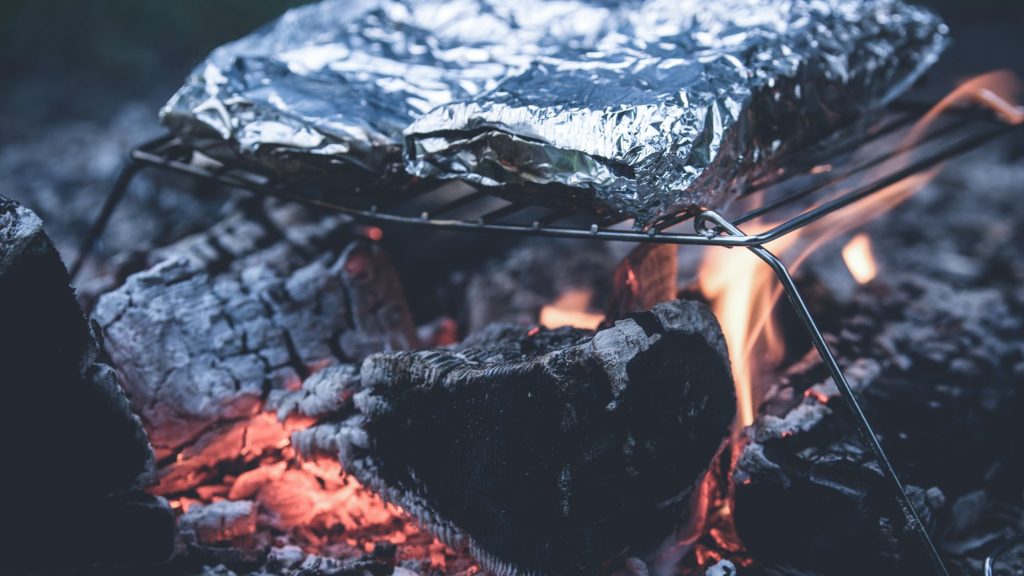
Foil packet cooking is a convenient and versatile method that involves wrapping food in aluminium foil and placing it directly on hot coals or a grill. This technique is ideal for cooking delicate fish, marinated vegetables, or even individual portions of lasagne. The foil creates a sealed environment, locking in moisture and flavours while simplifying clean-up.#
Campfire Skewering
Campfire skewering is a classic technique for cooking kebabs or skewered foods over an open flame. Simply thread marinated meats, vegetables, or even fruits onto skewers and position them near the heat source. This method offers endless possibilities for creative flavour combinations and allows for an interactive dining experience.
Solar Cooking

Harnessing the power of the sun, solar cooking utilises specially designed cookers that trap and convert sunlight into heat. These cookers are perfect for slow-cooking dishes, such as stews, rice, or even baking. Solar cooking is not only energy-efficient but also a sustainable and eco-friendly method of outdoor cooking.
Pizza Ovens
Using a pizza oven for outdoor cooking is a delightful culinary experience that elevates homemade pizzas to new heights. The dedicated oven, typically fuelled by wood, creates intense heat, infusing the pizzas with a distinct smoky flavour and achieving a crispy, charred crust. The process involves carefully stretching the dough, adding flavourful toppings, and swiftly placing the pizza into the preheated oven. With rapid cooking and even heat distribution, the pizzas emerge perfectly cooked, with bubbly cheese and irresistible aromas. Whether hosting a gathering or enjoying a family meal, cooking pizzas in a pizza oven adds a touch of authenticity and creates memorable outdoor dining moments.
Our pizza oven of choice is the Ooni Koda 12 it is compact enough to hide in the boot of your van and it connects easily to a butane or propane gas cannister. Pizzas in 60 seconds means hungry mouths are satisified pretty quick!
Outdoor cooking methods offer a delightful blend of tradition, adventure, and mouth-watering flavours. From the sizzle of the grill to the slow dance of the smoker and the crackle of the campfire, each method presents unique opportunities for culinary creativity. Armed with this comprehensive guide, you are ready to take on the great outdoors and create culinary masterpieces that will tantalise taste buds and leave lasting memories. Happy cooking!
Remember to check out vanlifeeats.com for more tips, tricks, and delectable recipes to elevate your outdoor cooking adventures. Let’s set your taste buds on fire with the ultimate culinary journey!
